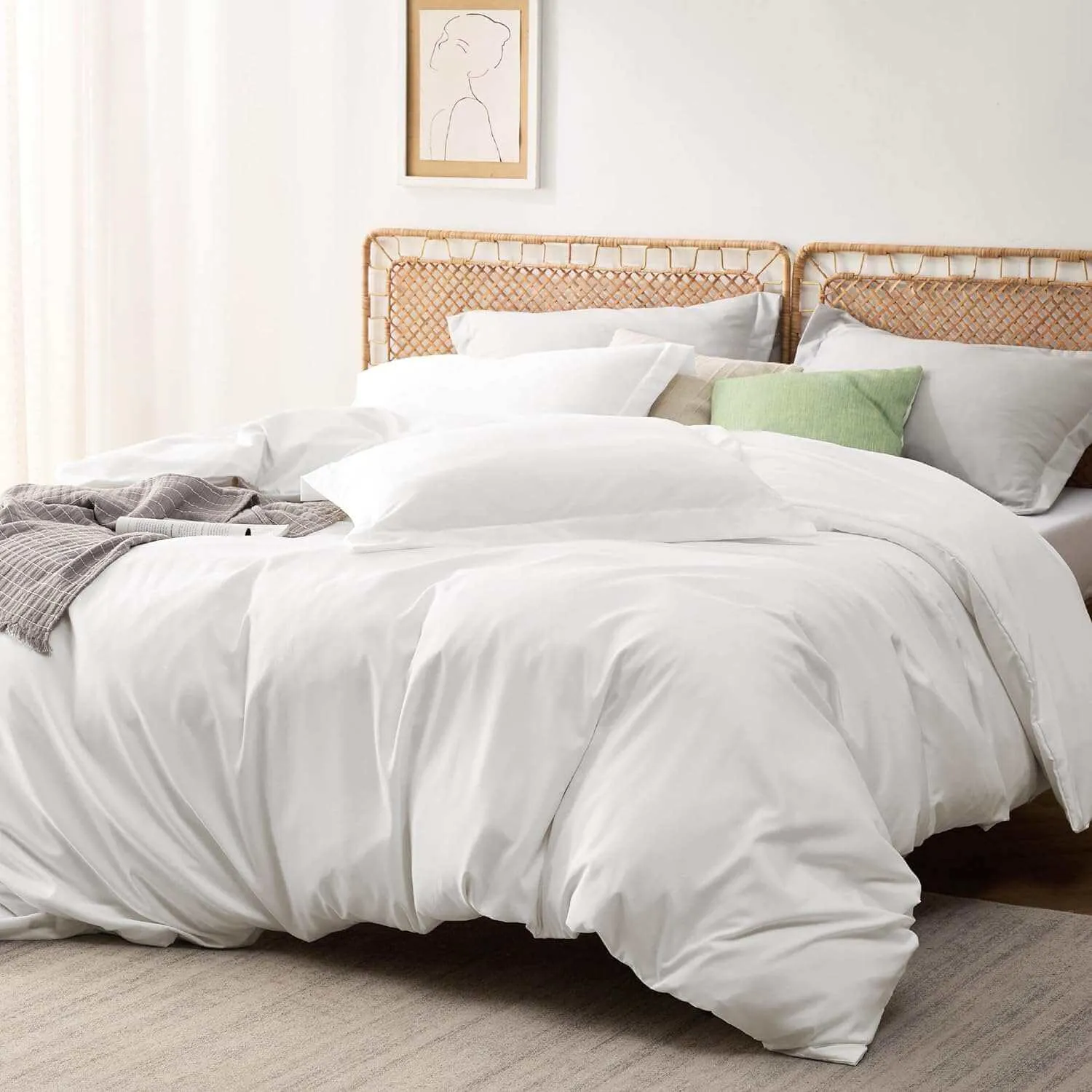Ultimate Guide to Eco Toppers: Bamboo Duvet Covers Australia for Sustainable, Hypoallergenic Comfort
Bamboo duvet covers are a modern bedding choice that combines natural fibres with performance benefits, offering breathability, moisture-wicking, and a soft, silky feel ideal for Australian homes. This guide explains what bamboo duvet covers are, why their hypoallergenic and temperature-regulating properties suit a range of sleepers, and how to choose and care for them so they last. Many Australians seek bedding that reduces allergens, stays cool in summer, and performs through variable climates, and bamboo meets those needs through specific fibre structure and weave choices. This article walks through material science, health benefits for allergy sufferers, practical buying criteria for Australian bed sizes, and clear care instructions to extend lifespan. We'll provide clear explanations, comparison tables against cotton and linen, and practical checklists to help you select the best bamboo duvet cover for your needs, so you can understand how product choices affect performance.
What Are Bamboo Duvet Covers and Why Are They Ideal for Australians?
Bamboo duvet covers are bed linen made from fibres derived from bamboo plants that are processed into soft yarns and woven into cover fabrics, delivering breathability and moisture control. The mechanism is simple: bamboo-derived fibres create microchannels that wick moisture away from the skin and allow air circulation, which reduces humidity next to the body and enhances thermal comfort. For Australian climates that range from humid coastlines to dry inland nights, these properties provide year-round practicality by keeping hot sleepers cool and reducing clamminess in humid weather. The following subsections explain fibre origins, hypoallergenic mechanisms, and thermoregulation so you can see how material choices translate to real-world sleep comfort.
What is bamboo fabric, and how is it used in duvet covers?
Bamboo fabric originates from the woody stalks of bamboo plants, where cellulose is extracted and regenerated into fibres commonly known as viscose-from-bamboo or lyocell variants, then spun into yarns for weaving. The fibre-to-fabric process influences texture and performance: mechanical processing yields a linen-like feel while regenerated viscose or lyocell gives a smoother, sateen-like finish; weave choice—sateen or percale—then determines sheen, drape, and durability. Manufacturers typically choose sateen weaves for a silky hand and percale for a crisp, breathable surface, and those choices affect how a duvet cover handles wear and laundering. Understanding these processing and weave differences helps you decide whether you prefer silky softness or a cooler, crisper finish.
The specific properties of bamboo fibres, such as their absorption capabilities, are a key factor in their performance in fabrics.
What unique properties make bamboo duvet covers hypoallergenic and antibacterial?

Bamboo duvet covers support hypoallergenic claims primarily through breathability and moisture control, which limit the damp environments that dust mites, mould, and bacteria need to thrive. Bamboo fibres wick sweat and humidity away from skin, reducing micro-environments that encourage microbial growth; this moisture-handling reduces odour formation and the frequency of allergen accumulation. Some bamboo-derived fabrics also exhibit natural anti-odour tendencies due to the fibre’s structure, helping maintain a fresher sleeping surface between washes. These mechanisms mean bamboo covers are a practical material choice for those seeking bedding that reduces allergen exposure without aggressive chemical treatments.
How do bamboo duvet covers regulate temperature for year-round comfort?
Bamboo fibre thermoregulation works by allowing efficient moisture evaporation and air exchange at the fabric surface, creating a cooling effect when you sweat and a breathable layer when temperatures drop. The microstructure of the fibre and the chosen weave allow heat to dissipate more readily than heavy, non-breathable fabrics, which helps hot sleepers stay cooler during warm Australian summers. For cooler months, bamboo’s insulating properties when layered with the right fill still provide comfort by trapping a modest layer of warm air close to the body, so pairing a bamboo cover with seasonal fills offers year-round flexibility. Practical application: choose a weave and layer strategy based on whether you prioritise cooling or a plush, warmer feel.
Bamboo offers several clear performance benefits for sleep:
- Breathability and Coolness: Bamboo fabrics transport moisture and heat away from the body, aiding sleep temperature regulation.
- Hypoallergenic Performance: Reduced moisture lowers dust mite and mould risk, helping sensitive sleepers.
- Softer Hand Feel: Regenerated bamboo yarns can deliver a smooth, silky surface that improves comfort and reduces friction on skin.
These points clarify why bamboo duvet covers are well-suited to diverse Australian sleeping conditions and preferences.
Why Choose EcoToppers Bamboo Duvet Covers?
EcoToppers is an Australian family-run business that sells and promotes premium eco-friendly bedding, with a strong focus on bamboo sleep products designed for comfort, relief, and sustainability. The brand emphasises natural performance benefits—naturally hypoallergenic, antibacterial tendencies, and temperature regulation—while promoting biodegradable materials and practical customer satisfaction. EcoToppers positions its collection to suit Australians seeking sustainable bedding options, offering flexible purchasing and delivery options designed for local buyers. Below, a product-focused comparison table highlights key attributes of EcoToppers’ bamboo covers relative to conventional alternatives, followed by deeper detail on comfort, sourcing emphasis, and customer support.
The EcoToppers difference can be summarised through product attributes and benefits to help you evaluate value and suitability.
| Product Attribute | EcoToppers Bamboo Cover | Conventional Cotton/Linen Cover |
|---|---|---|
| Material feel | Silky, smooth with moisture-wicking fibres | Varies: cotton softer or linen textured |
| Hypoallergenic potential | Naturally reduces moisture and microbial growth | Cotton can retain moisture; linen breathes well |
| Temperature regulation | Strong moisture-wicking and cooling | Cotton is breathable; linen is excellent in heat |
| Sustainability emphasis | Biodegradable materials and family-run eco focus | Varies by brand and treatment |
How does EcoToppers ensure comfort and support in their bamboo duvet covers?
EcoToppers focuses on fabric and construction choices that maximise the inherent comfort of bamboo fibres while preserving breathability and drape, combining weave selection and finishing to achieve a soft, supportive cover. The weave and finish determine tactile qualities—sateen weaves provide a smooth, slightly lustrous surface that promotes restful sleep, while percale weaves favour crisp cooling—so EcoToppers tailors options to different sleep preferences. Properly chosen closures and corner ties (meronyms of a duvet cover) also support fit and reduce duvet movement inside the cover, improving sleep consistency. Understanding these design considerations helps shoppers choose a style that matches their sleep posture and comfort priorities.
What sustainability and ethical sourcing practices does EcoToppers follow?
EcoToppers emphasises eco-friendly materials and a family-run Australian identity, positioning sustainability and biodegradability as core brand priorities rather than making specific certification claims. The company highlights using bamboo-based materials that are more biodegradable than many synthetic alternatives and aligns product messaging with reduced environmental impact where possible. Ethical sourcing focus is described in general terms, consistent with a family-run brand ethos that values traceability and local-market alignment. For shoppers evaluating sustainability, these stated priorities provide a baseline for further verification and comparison against product details and labels.
What customer support and delivery options does EcoToppers offer in Australia?
EcoToppers aims for customer satisfaction, offering flexible options to ensure you're happy with your purchase. We provide convenient delivery options across Australia and can support various purchasing needs, making our premium bedding accessible. Our focus is on making your buying experience smooth and confident.
What Are the Health Benefits of Bamboo Duvet Covers for Allergy Sufferers?
Bamboo duvet covers reduce allergen exposure primarily through moisture management and breathability, lowering conditions that promote dust mite populations and microbial growth. The mechanism is straightforward: by wicking sweat and lowering humidity at the sleep surface, bamboo makes the mattress environment less hospitable to allergens, which can translate into fewer symptomatic triggers for sensitive individuals. In addition to material effects, regular laundering and using suitable allergen-proof encasements further reduce household allergen loads, producing a layered approach to allergy management. The following subsections expand on mechanisms, suitability for sensitive skin, and how customer feedback can validate real-world outcomes.
How do bamboo duvet covers reduce allergens and bacteria?
Bamboo fibres help reduce allergens and bacteria by moving moisture away from skin and creating drier fabric surfaces, which diminishes the breeding ground for dust mites and mould. Less moisture reduces bacterial proliferation and odour-causing microbes, leading to a cleaner-feeling sleep environment between washes. Routine maintenance—washing covers regularly at recommended settings and pairing covers with suitable mattress protection—amplifies these material benefits and helps maintain lower household allergen levels. This layered strategy provides both passive control via fabric choice and active control via care routines.
Why are bamboo duvet covers suitable for sensitive skin and asthma sufferers?
Bamboo fabrics are gentle on skin due to a smooth fibre surface and low friction finish, reducing irritation for sensitive or reactive skin types, while their moisture-management reduces triggers that aggravate respiratory symptoms. For asthma sufferers, lowering dust mite populations and mould exposure through drier bedding surfaces can reduce environmental triggers that provoke symptoms, though individual responses vary. Medical advice is recommended for people with severe allergies or asthma, but bamboo covers provide a non-pharmaceutical, material-based step that can complement clinical interventions. Choosing breathable, washable covers and maintaining a clear care routine helps maximise these benefits.
What do customers say about allergy relief with EcoToppers bamboo duvet covers?
Customer feedback is an important form of real-world validation for health claims, and EcoToppers encourages the use of verified reviews to understand typical outcomes after switching to bamboo bedding. While specific testimonials should be reviewed on product pages for direct quotes, common themes often include improved sleep comfort, reduced nighttime sweating, and easier maintenance compared with heavier or less breathable fabrics. Collecting and comparing local customer experiences can help allergy sufferers gauge likely benefits, and pairing covers with other hypoallergenic bedding items increases the chance of meaningful relief. For sensitive users, flexible return options make it easier to test products without long-term commitment.
For allergy management, consider these practical steps:
- Layer fabric choices: Use a bamboo duvet cover with a washable, allergen-proof mattress encasement to reduce exposure.
- Maintain a washing schedule: Wash covers regularly to remove accumulated allergens and perspiration.
- Monitor bedroom humidity: Reducing room humidity below ideal thresholds discourages dust mite proliferation.
How to Choose the Perfect Bamboo Duvet Cover for Your Australian Bed?
Selecting the right bamboo duvet cover involves matching size, weave, thread count, context, and style to your bed dimensions and sleep preferences. Key decision factors include correct Australian sizing, weave type (sateen vs percale), and recommended thread count ranges contextualised for bamboo fibres, where a moderate thread count often balances softness with breathability. The table below provides exact size guidance and typical weave/thread count recommendations to reduce sizing errors and ensure the cover fits properly. After specifications, consider colour and practical style choices for durability and bedroom cohesion.
| Size / Spec | Attribute | Typical Value / Recommendation |
|---|---|---|
| Single | Dimensions | Use standard Single measurements for Australian beds; allow 10–20 cm extra for tucking. |
| Queen | Dimensions | Queen fits most Australian double beds; check inner duvet dimensions before buying. |
| Thread count/weave | Fabric quality | Moderate thread count with sateen for a smooth feel, percale for cooler crispness |
What sizes are available for bamboo duvet covers in Australia?
Australian standard sizes typically include Single, Double, Queen, King, and Super King, and choosing the correct cover requires matching the internal duvet or doona dimensions rather than mattress size. Measure your existing duvet from edge to edge and compare those internal measurements to cover listings to ensure a snug fit; allowing an extra 10–20 centimetres can help with tucking and accommodation of loftier fills. Where available, choose covers with corner ties or internal straps to secure the insert and reduce shifting during use. Correct sizing reduces bunching, improves sleep comfort, and extends the effective life of both cover and fill.
How do thread count and fabric weave affect bamboo duvet cover quality?
Thread count describes how many yarns per square inch are used in woven fabric, but for bamboo-derived textiles, the fibre quality and weave often matter more than extremely high thread counts. Moderate thread counts combined with a sateen weave give bamboo covers a smooth, luxurious hand while preserving breathability; very high thread counts can reduce airflow and undermine cooling benefits. Percale weaves favour a crisp, cooler feel suitable for hot sleepers, while sateen emphasises softness and drape for those prioritising a silky surface. Choose weave and thread count based on whether cooling or plushness is the priority.
What colour and style options does EcoToppers offer?
EcoToppers presents a curated selection of colours and understated styles that prioritise timeless bedroom coordination and practical wear resistance, focusing on neutral and muted palettes that suit Australian interiors. Colour selection affects maintenance—darker tones may hide minor stains while light neutrals show wear but brighten a room—so choose based on lifestyle factors like laundry frequency and household use. For style cohesion, match cover tones to sheet sets and bedroom accents to create a layered, restful aesthetic that complements the cover’s natural texture. Knowing available colourways helps you visualise the finished bed and choose functional hues suited to everyday living.
Choosing the right cover also involves deciding on closure type and additional features:
- Zipper closures provide a secure seal and ease of laundering.
- Button or envelope closures offer a softer aesthetic and simpler repairs.
- Corner ties keep the duvet insert stable and reduce internal shifting.
How Do You Care for and Maintain Bamboo Duvet Covers?
Caring for bamboo duvet covers preserves their softness, colour, and performance; recommended practices focus on gentle washing, mild detergents, and careful drying to avoid shrinkage and fibre damage. Proper laundering removes accumulated oils and allergens while maintaining the fabric’s moisture-handling properties, and storage practices prevent long-term degradation from sunlight or pests. Below are practical washing steps and lifespan-extension tips presented as actionable lists, followed by a brief comparative note versus cotton and linen care to help set expectations.
The longevity and user satisfaction with bedding products are significantly influenced by how they are cared for and maintained.
Follow these washing and drying steps for reliable care:
- Use a gentle cycle: Wash on a cool-to-warm gentle cycle to protect fibres and weave.
- Choose mild detergent: Use a pH-neutral, enzyme-free detergent to avoid fibre breakdown.
- Avoid high heat drying: Tumble dry on low or line-dry in shade to prevent shrinkage and preserve softness.
What are the best washing and drying practices for bamboo duvet covers?
Wash bamboo covers on a gentle cycle with cool to warm water and mild, enzyme-free detergent to avoid fibre weakening and colour fading. Avoid bleach and harsh stain removers; treat stains with a gentle pre-wash approach and launder promptly to prevent set-in marks. Drying on low heat or line-drying in shade preserves fibre length and prevents excess shrinkage, while removing covers promptly from the dryer reduces creasing and maintains a smooth hand. Following these settings reliably maintains moisture-wicking properties and the cover’s comfortable surface over many cycles.
How can you extend the lifespan of your bamboo duvet cover?
To extend lifespan, rotate covers and sheets regularly to distribute wear, store them folded in breathable containers away from direct sunlight, and repair minor snags or seam issues promptly to prevent larger failures. Avoid exposing covers to prolonged direct UV light, which can weaken fibres and fade colours, and limit contact with rough surfaces or abrasive accessories that can pill or abrade the weave. Gentle handling during laundering, including using garment bags for delicate items, reduces mechanical stress and retains softness. These simple care habits prolong both aesthetics and functional performance.
Are bamboo duvet covers easy to care for compared to cotton or linen?
Bamboo covers are generally easy to maintain and often require less frequent harsh washing because their moisture-wicking and odour-resistant properties keep them feeling fresh longer between washes. Cotton is straightforward to launder but can retain more moisture and may require higher-heat drying to remove allergens; linen is robust and breathable but becomes softer with repeated washing and can wrinkle more. Bamboo achieves a favourable balance: it offers low-maintenance freshness with mild care routines while delivering superior moisture control compared to many cotton options. Choose based on your tolerance for ironing, laundering frequency, and desired texture.
How Do Bamboo Duvet Covers Compare to Cotton and Linen Alternatives?
Comparing bamboo to cotton and linen clarifies trade-offs in breathability, sustainability, and feel so you can make an informed choice for your bedroom. Bamboo typically excels in moisture-wicking and a silky, low-friction surface, cotton offers versatility and broad availability, and linen provides exceptional breathability and a textured aesthetic favoured in hot climates. The table below breaks down key attributes across the three fibres to give a concise view of where each material performs best and how care requirements differ.
| Attribute | Bamboo | Cotton | Linen |
|---|---|---|---|
| Breathability | High, strong moisture-wicking | Medium-high, varies by weave | High, excels in heat |
| Hypoallergenic potential | High due to moisture control | Moderate, depends on treatment | Moderate-high, naturally breathable |
| Durability | Good with proper care | Good, strong fibres | Very durable, softens over time |
| Care requirements | Gentle wash, low heat dry | Easy, tolerates warmer washes | Requires gentle handling, less shrinkage over time |
What are the key differences between bamboo and cotton duvet covers?
Bamboo generally offers superior moisture-wicking and a silky hand compared with standard cotton, which can vary widely by fibre type and weave; cotton’s strengths include easy care and widespread availability. Bamboo’s structure promotes drier surface conditions that reduce dust mite risk, while cotton can retain more moisture depending on weave and finish. Economically, both fibres come in many price tiers, so focus on weave, finish, and supplier transparency rather than fibre alone when comparing quality. Ultimately, the right choice depends on whether you prioritise cooling and hypoallergenic performance (bamboo) or easy-care versatility (cotton).
How does bamboo compare to linen in terms of sustainability and comfort?
Bamboo and linen both present sustainability advantages over many synthetic fabrics, but trade-offs exist: linen is derived from flax, a low-water crop with minimal pesticide needs, while bamboo’s sustainability depends on processing methods and chemical usage in fibre regeneration. Comfort-wise, linen breathes exceptionally well and develops a relaxed texture over time, while bamboo provides a smoother, silk-like surface and strong moisture management. If you prioritise a textured, naturally rustic aesthetic with long-term durability, linen is excellent; for silky softness with cooling performance, bamboo may be preferable.
Which duvet cover material is best for hot sleepers and allergy sufferers?
For hot sleepers, both bamboo and linen are top choices: bamboo for moisture-wicking and a smoother cool feel, linen for outstanding airflow and a breezy texture in very hot climates. For allergy sufferers, bamboo’s moisture control can reduce dust mite and mould prevalence, making it a strong option when combined with allergen-proof encasements and regular washing. Pair the chosen cover with an appropriate fill—lightweight summer fill for hot sleepers, layered fills for cooler months—to maximise comfort and health outcomes. Selecting material based on sleep profile and maintenance willingness yields the best long-term results.
What Are the Most Frequently Asked Questions About Bamboo Duvet Covers in Australia?
This final section answers common buyer queries directly and practically to support purchase decisions, including product suitability, thermoregulation, where to buy locally, and how to verify sustainability claims. Short, specific answers help capture featured snippets and provide concise advice for quick reference. Business-specific purchasing guidance and assurances from EcoToppers are included where helpful to support local buyers who value convenient delivery and flexible return options.
Are EcoToppers bamboo duvet covers truly hypoallergenic?
Yes—EcoToppers’ bamboo duvet covers are positioned as naturally hypoallergenic because their moisture-wicking and breathable properties reduce conditions that support dust mites and microbial growth, which are common triggers for allergic reactions. This material-based hypoallergenic potential is enhanced when users maintain a regular washing schedule and use complementary allergen-proof bedding products. Individual sensitivities vary, so people with severe allergies should consult health professionals before making changes to bedding materials. Overall, the fabric’s performance characteristics align with common hypoallergenic strategies used by sleep-health professionals.
How do bamboo duvet covers keep you cool in summer and warm in winter?
Bamboo covers keep you cool by wicking moisture and facilitating evaporative cooling at the skin surface, while in cooler months, they can be paired with insulating fills to trap a thin layer of warm air close to the body for comfort. The material’s breathability allows heat to escape, preventing overheating, and layering strategies (light fill in summer, heavier fill in winter) leverage bamboo’s versatile thermal management. Practical use: swap duvet fills seasonally rather than changing covers to maintain fabric longevity and achieve year-round temperature control.
Where can I buy the best bamboo duvet covers in Australia?
For local buyers looking for a reliable, eco-focused option, consider Australian suppliers who offer great customer support and convenient delivery. EcoToppers is a family-run Australian bedding business that provides bamboo duvet covers, focusing on sustainability and customer satisfaction. When choosing a supplier, look for clear sizing charts and support for various purchasing needs. Opting for a local supplier often means simpler returns, quicker shipping, and excellent post-purchase assistance.
How do I know if a bamboo duvet cover is sustainably made?
Use a simple verification checklist: look for transparent material descriptions, evidence of biodegradable materials, information on processing methods, and clear supply-chain statements; certifications help but may not always be present. Ask sellers about processing (mechanical vs. regenerated fibre methods), look for statements on biodegradability, and check for local brand commitments to eco-friendly practices. Interpreting claims responsibly means seeking specifics rather than accepting generic sustainability language.
Can bamboo duvet covers help with skin allergies and asthma?
Bamboo covers can help reduce exposure to common bedding triggers by managing moisture and reducing environments that encourage dust mites and mould, which may benefit people with mild to moderate skin allergies or asthma triggers; however, they are not a medical treatment. Combining bamboo covers with allergen-proof encasements, regular washing, and medical advice forms a comprehensive approach to symptom management. For clinical guidance, consult healthcare professionals to integrate material choices into an overall treatment or avoidance strategy.
- Check material and care labels: Confirm fibre type and laundering instructions before purchase.
- Compare customer support: Prefer sellers offering flexible return policies to test real-world benefits.
- Combine strategies: Use bamboo covers alongside mattress encasements and consistent cleaning for best allergy control.
| Specification | Attribute | Value |
|---|---|---|
| Care Checklist | Washing & Drying | Gentle cycle, mild detergent, low-heat or line-dry |
| Buying Checklist | Fit & Features | Match duvet dimensions, use corner ties, and choose a suitable weave |
| Health Checklist | Allergy Support | Pair with encasements, maintain washing schedule, monitor humidity |






